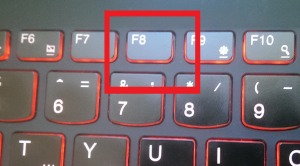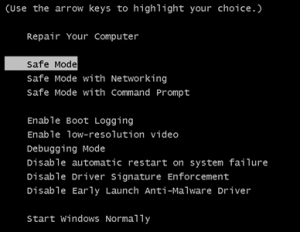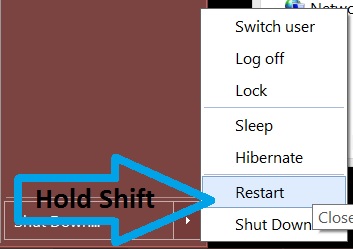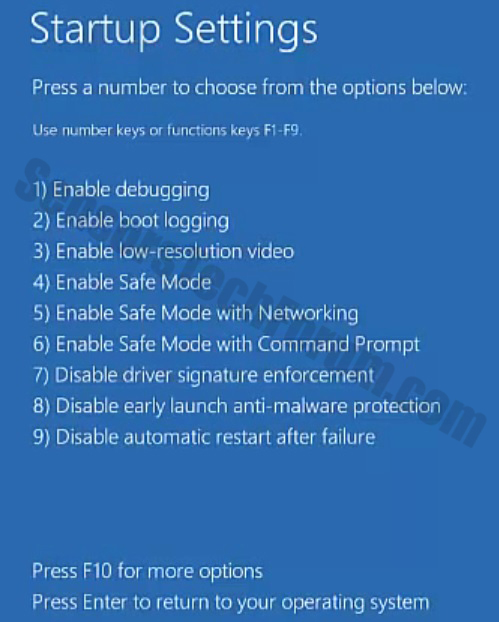Win32:Atraps-PZ[Trojan] is a Trojan horse that was discovered a couple of years ago. However, new attacks initiated by the Trojan have been just detected in the wild.
| Name | Win32:Atraps-PZ[Trojan] |
| Type | Trojan Horse, Worm |
| Short Description | The threat may create a shortcut of a file and then hide it. |
| Symptoms | Alerts by the AV software, is such is present on the system. |
| Distribution Method | Infected external memory devices, torrent clients, pirated software, spam, zero-day vulnerabilities. |
| Detection tool | Download Malware Removal Tool, to See If Your System Has Been Affected By Win32:Atraps-PZ[Trojan] |
Win32:Atraps-PZ[Trojan] Threat Description. Similarities with Other Malware
Some users may refer to the threat as a shortcut virus. Win32:Atraps-PZ[Trojan] has been reported to create a shortcut of a file and then hide it.
Must Read
Worm:VBS/Tibni.A
Types of Trojan Attacks
According to research, Win32:Atraps-PZ[Trojan] may come from the family of the TR/ATRAPS.Gen2 virus. The virus itself is closely related to the ZeroAccess rootkit. Since Trojan horses can be employed as backdoors or malware droppers, there is a possibility that Win32:Atraps-PZ[Trojan] has been used to spread the virus. However, more information is needed to confirm that. One way to know that your system has been affected by a malicious threat from the Atraps family is if you have witnessed the following alert:
→“Access to file containing the virus or unwanted program ‘TR/ATRAPS.Gen2’ was blocked”
Users should keep in mind that malware from the Atraps family has been circulating for several years. It’s only logical that the threats have many new and updated variants, with multiple functionality modifications to improve the persistence of the infection.
TR/ATRAPS.Gen2 has been reported to have kernel-mode rootkit capabilities. It can hide itself on the targeted machine, be it 32 or 64-bit. It also has aggressive self-defense capabilities. Overall, the threat has been identified as quite malicious and sophisticated.
It seems that Win32:Atraps-PZ[Trojan] is a variant of the malware family that has been written especially for 32-bit Windows. Now, let’s see how the threat is distributed.
Win32:Atraps-PZ[Trojan] Distribution Technique
Malware classified as a Trojan horse, virus or rootkit is primarily distributed through:
- Infected external memory devices – USB drives, CDs, etc.
- P2P networks and file sharing – such as torrents.
- Spam emails and corrupted email attachments.
- Zero-day vulnerabilities.
In particular, Trojans and viruses seem to prefer being spread via exploit kits and programs that are associated with software-piracy – keygens and cracks mostly. In that sense, users who tend to use such pieces of counterfeit software are more endangered. However, any machine that doesn’t support one or more AV solutions is at risk of a malicious intrusion.
In addition, Trojans such as Win32:Atraps-PZ[Trojan] may be dropped or installed by other malicious software. The vice versa scenario is also probable – Trojans may be employed to spread adware and potentially unwanted program. The end goal of the whole procedure of infection may be to carry out click fraud and generate income for the botnet authors.
Here is a list of possible Win32:Atraps-PZ[Trojan] detections:
- Exploit.CplLnk.Gen.2
- Exploit.CVE-2010-2568.Gen
- Exploit.Cpllnk
- LNK/Autostart.A
- Worm/Win32.Bundpil
- Worm.Win32.Bundpil.T
- Win32:Atraps-PZ
- win32 Atraps-PF
- Win32.Troj.Generic.a.(kcloud)
- Downloader-FKP!4963B9D65B37
Win32:Atraps-PZ[Trojan] Removal Options
There are cases of users who have removed the Trojan only to find out that it re-appeared after a while. It is clear that the infection is quite intrusive and persistent. To completely eradicate it, an AV software specialized in removing spyware threats is required.
What you can do is first scan your Registry via specialized registry cleaner program. Then apply an AV scanner. The step-by-step removal guide below the article may be tried as well. However, keep in mind that this particular Trojan can be stealthier than other Trojans. Using professional tools to eliminate it completely is recommended.
Step 1: Start Your PC in Safe Mode to Remove Win32:Atraps-PZ[Trojan].
Removing Win32:Atraps-PZ[Trojan] from Windows XP, Vista, 7 systems:
1. Remove all CDs and DVDs, and then Restart your PC from the “Start” menu.
2. Select one of the two options provided below:
– For PCs with a single operating system: Press “F8” repeatedly after the first boot screen shows up during the restart of your computer. In case the Windows logo appears on the screen, you have to repeat the same task again.
– For PCs with multiple operating systems: Тhe arrow keys will help you select the operating system you prefer to start in Safe Mode. Press “F8” just as described for a single operating system.
3. As the “Advanced Boot Options” screen appears, select the Safe Mode option you want using the arrow keys. As you make your selection, press “Enter“.
4. Log on to your computer using your administrator account
While your computer is in Safe Mode, the words “Safe Mode” will appear in all four corners of your screen.
Removing Win32:Atraps-PZ[Trojan] from Windows 8, 8.1 and 10 systems:
Substep 1:
Substep 2:
Whilst holding down Shift button, click on Power and then click on Restart.
Substep 3:
After reboot, the aftermentioned menu will appear. From there you should choose Troubleshoot.
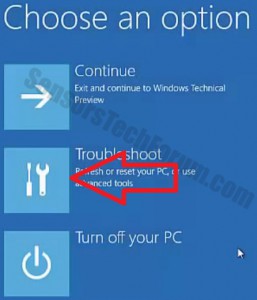
Substep 4:
You will see the Troubleshoot menu. From this menu you can choose Advanced Options.
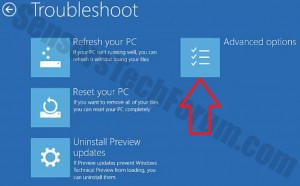
Substep 5:
After the Advanced Options menu appears, click on Startup Settings.
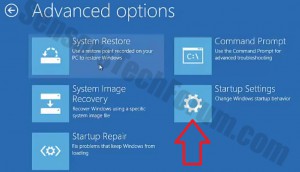
Substep 6:
Substep 7:
A menu will appear upon reboot. You should choose Safe Mode by pressing its corresponding number and the machine will restart and boot into Safe Mode so you can scan for and remove Win32:Atraps-PZ[Trojan].
Step 2: Remove Win32:Atraps-PZ[Trojan] automatically by downloading an advanced anti-malware program.
To clean your computer you should download an updated anti-malware program on a safe PC and then install it on the affected computer in offline mode. After that you should boot into safe mode and scan your computer to remove all Win32:Atraps-PZ[Trojan] associated objects.
Preparation before removing Win32:Atraps-PZ[Trojan].
Before starting the actual removal process, we recommend that you do the following preparation steps.
- Make sure you have these instructions always open and in front of your eyes.
- Do a backup of all of your files, even if they could be damaged. You should back up your data with a cloud backup solution and insure your files against any type of loss, even from the most severe threats.
- Be patient as this could take a while.
- Scan for Malware
- Fix Registries
- Remove Virus Files
Step 1: Scan for Win32:Atraps-PZ[Trojan] with SpyHunter Anti-Malware Tool



Step 2: Clean any registries, created by Win32:Atraps-PZ[Trojan] on your computer.
The usually targeted registries of Windows machines are the following:
- HKEY_LOCAL_MACHINE\Software\Microsoft\Windows\CurrentVersion\Run
- HKEY_CURRENT_USER\Software\Microsoft\Windows\CurrentVersion\Run
- HKEY_LOCAL_MACHINE\Software\Microsoft\Windows\CurrentVersion\RunOnce
- HKEY_CURRENT_USER\Software\Microsoft\Windows\CurrentVersion\RunOnce
You can access them by opening the Windows registry editor and deleting any values, created by Win32:Atraps-PZ[Trojan] there. This can happen by following the steps underneath:


 Tip: To find a virus-created value, you can right-click on it and click "Modify" to see which file it is set to run. If this is the virus file location, remove the value.
Tip: To find a virus-created value, you can right-click on it and click "Modify" to see which file it is set to run. If this is the virus file location, remove the value.Step 3: Find virus files created by Win32:Atraps-PZ[Trojan] on your PC.
1.For Windows 8, 8.1 and 10.
For Newer Windows Operating Systems
1: On your keyboard press + R and write explorer.exe in the Run text box and then click on the Ok button.

2: Click on your PC from the quick access bar. This is usually an icon with a monitor and its name is either “My Computer”, “My PC” or “This PC” or whatever you have named it.

3: Navigate to the search box in the top-right of your PC's screen and type “fileextension:” and after which type the file extension. If you are looking for malicious executables, an example may be "fileextension:exe". After doing that, leave a space and type the file name you believe the malware has created. Here is how it may appear if your file has been found:

N.B. We recommend to wait for the green loading bar in the navigation box to fill up in case the PC is looking for the file and hasn't found it yet.
2.For Windows XP, Vista, and 7.
For Older Windows Operating Systems
In older Windows OS's the conventional approach should be the effective one:
1: Click on the Start Menu icon (usually on your bottom-left) and then choose the Search preference.

2: After the search window appears, choose More Advanced Options from the search assistant box. Another way is by clicking on All Files and Folders.

3: After that type the name of the file you are looking for and click on the Search button. This might take some time after which results will appear. If you have found the malicious file, you may copy or open its location by right-clicking on it.
Now you should be able to discover any file on Windows as long as it is on your hard drive and is not concealed via special software.
Win32:Atraps-PZ[Trojan] FAQ
What Does Win32:Atraps-PZ[Trojan] Trojan Do?
The Win32:Atraps-PZ[Trojan] Trojan is a malicious computer program designed to disrupt, damage, or gain unauthorized access to a computer system. It can be used to steal sensitive data, gain control over a system, or launch other malicious activities.
Can Trojans Steal Passwords?
Yes, Trojans, like Win32:Atraps-PZ[Trojan], can steal passwords. These malicious programs are designed to gain access to a user's computer, spy on victims and steal sensitive information such as banking details and passwords.
Can Win32:Atraps-PZ[Trojan] Trojan Hide Itself?
Yes, it can. A Trojan can use various techniques to mask itself, including rootkits, encryption, and obfuscation, to hide from security scanners and evade detection.
Can a Trojan be Removed by Factory Reset?
Yes, a Trojan can be removed by factory resetting your device. This is because it will restore the device to its original state, eliminating any malicious software that may have been installed. Bear in mind that there are more sophisticated Trojans that leave backdoors and reinfect even after a factory reset.
Can Win32:Atraps-PZ[Trojan] Trojan Infect WiFi?
Yes, it is possible for a Trojan to infect WiFi networks. When a user connects to the infected network, the Trojan can spread to other connected devices and can access sensitive information on the network.
Can Trojans Be Deleted?
Yes, Trojans can be deleted. This is typically done by running a powerful anti-virus or anti-malware program that is designed to detect and remove malicious files. In some cases, manual deletion of the Trojan may also be necessary.
Can Trojans Steal Files?
Yes, Trojans can steal files if they are installed on a computer. This is done by allowing the malware author or user to gain access to the computer and then steal the files stored on it.
Which Anti-Malware Can Remove Trojans?
Anti-malware programs such as SpyHunter are capable of scanning for and removing Trojans from your computer. It is important to keep your anti-malware up to date and regularly scan your system for any malicious software.
Can Trojans Infect USB?
Yes, Trojans can infect USB devices. USB Trojans typically spread through malicious files downloaded from the internet or shared via email, allowing the hacker to gain access to a user's confidential data.
About the Win32:Atraps-PZ[Trojan] Research
The content we publish on SensorsTechForum.com, this Win32:Atraps-PZ[Trojan] how-to removal guide included, is the outcome of extensive research, hard work and our team’s devotion to help you remove the specific trojan problem.
How did we conduct the research on Win32:Atraps-PZ[Trojan]?
Please note that our research is based on an independent investigation. We are in contact with independent security researchers, thanks to which we receive daily updates on the latest malware definitions, including the various types of trojans (backdoor, downloader, infostealer, ransom, etc.)
Furthermore, the research behind the Win32:Atraps-PZ[Trojan] threat is backed with VirusTotal.
To better understand the threat posed by trojans, please refer to the following articles which provide knowledgeable details.


